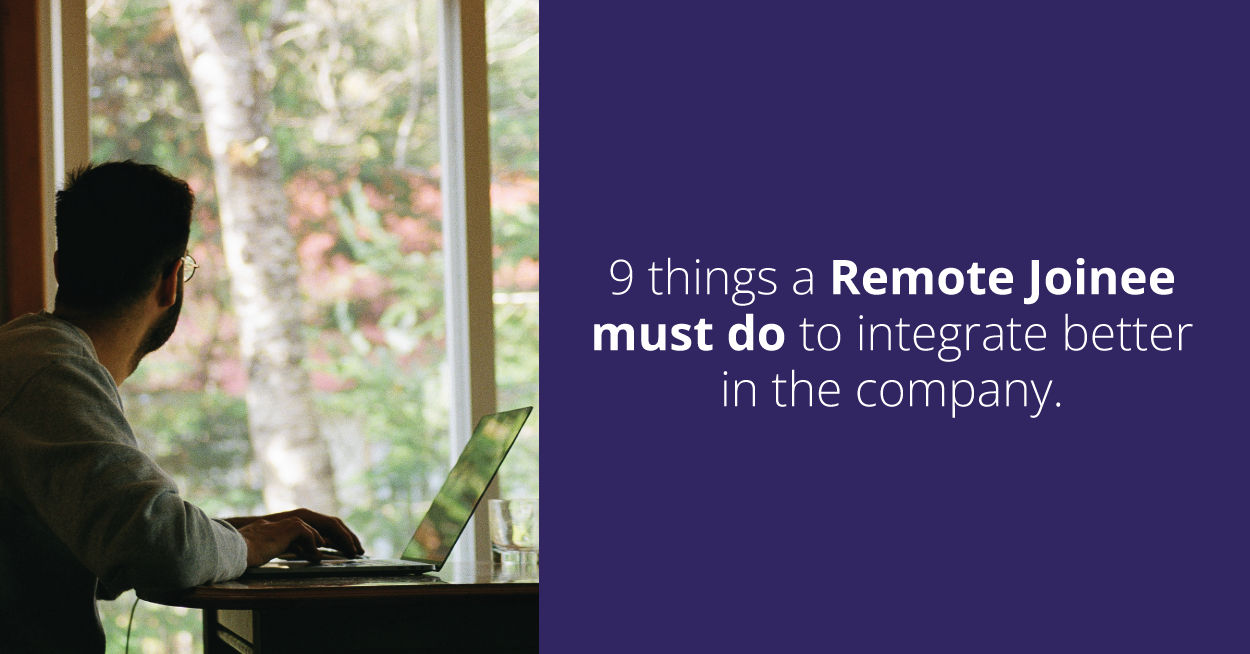
9 Things A Remote Joinee Must Do To Integrate Better In The Company

A study by Gallup found that only 12% of employees agree that employers do a great job in onboarding new hires.
Making new hires feel welcomed has been an uphill battle, especially in a remote setup, a change which we believe will outlast the pandemic.
From “Yay, I have a new job role” to “I don’t think I belong here!?”, it’s all slippery down the remote working scenario, if not taken care of at the right time.
In a recent article published by us, we have suggested a few best practices for employers to engage better in a remote setup. While employers do their part, it is also essential that we, as employees, also give our best at integrating with the team and work culture.
Here are a few tips for the same:
1. Just Do Your Own Work-Space
Imagine your day 1 at work in a new office space, what do you see? New faces, new set-up, the new vibe – everything closely summing up and suggesting a change right from the very start. But in a remote setting, there are hardly any physical changes to consider. So what do you do?
We suggest you mark this transition in your life by setting up a physical space specifically for work in your house. And if you already have one, start by revamping it to replicate a bit of ‘newness.’ Add elements, move directions, buy a new chair – do anything that embraces the change and sets the vibe for you to begin working!
2. Clear all bases with your manager
When working remotely based on deadlines, employees find it difficult to extract the overall purpose from day-to-day micro-jobs assigned. A report launched by Azcentral suggests, 28% of employees cite poor communication as the reason for not being able to deliver work on time.

Take orientation a step forward with in-depth discussions with your manager. Ask questions about your organisation’s goals and changes in priorities, if any. Prioritise and streamline your individual goals in a way that adds to your organisation’s purpose.
3. Pick ‘Real’ Work Hours
Remember, it is work from home, not work 24*7. The downside of all the flexibility that a remote set-up provides is that employees often tend to overstep the boundaries between work & life.
Setting up a log-in and log-out time and abiding by the clock hours can help you create a balance, thus, increasing happiness and productivity. You can recognise your highly-productive phases and plan your hours accordingly.
4. Follow a standard for communications
In a remote work setting, learning to communicate better is not a one-way street for employers.Understand how your team communicates. A recent database by CosoCloud database suggests that Email is the primary method of communication for remote workers, followed by instant messaging and video chat.
Find out what your team relies on? Do they prefer emails or do they find texting time-consuming? Does your manager encourage video calls during meetings? Identify these and consider them while setting your standards for communications. And if there are no clear guidelines, begin by asking a simple question to your peers- “What’s the best way to communicate with you?.”
5. Make some efforts to know the team better
Recently, McKinsey released a stat that suggests, ‘Organisations with connected employees show productivity increases of 20-25%.’ But how do you stay connected when you’ve just joined remotely? As a new joinee, it can get tedious to know people without meeting them physically.

We suggest you take out 30-45 minutes of your week for pure networking, outside what the company sets up for you. Start by sending invites to peers who are directly related to your job function. Take a step forward by arranging introductions with teammates you should be knowing. Replace the ‘walk up to your peer’s desk’ with a meeting invite and watch yourself network better internally.
6. Acknowledge the learning curve.
Don’t beat yourself up if you’re unable to comprehend work already. The first few months of your job as a remote new joinee can be uncertain and disjointing, but it’s not the time to feel misplaced.
Cut yourself some slack when immersing yourself in a new ecosystem with new roles, different connections, and varied norms. Accept the fact that it’s a process and acknowledges the same through dedicated learning and adaptability.
7. Keep your calendar up-to-date
The biggest enemy to productivity is procrastination. When working from home, it is easy for you to lose sight of tasks, deadlines, and priorities throughout the day.
Spend the first fifteen minutes of your day prioritising your actions as per deadlines. Make a to-do list and add it up to your calendar for the day. You can use a simple Google calendar or add it to your Project management Tool. Steer clear of distractions by setting time limits for each task. Do this every day to contribute effectively and keep your team informed on your schedules.
8. Plan it out with your manager
You are already keeping track of your day-to-day calendar and have set goals to achieve daily/weekly. But are these goals aligned with what’s expected of you to take on priority? Keeping your manager in the loop of your planning can help you solve just that!
Set up a daily/weekly catch-up with your manager to plan your work better. You can begin by setting up a 15 minutes call on a Monday morning to set clear goals & timelines, and on a Friday, discuss the accomplishments and backlogs, if any. Maintain an email chain that captures these discussions to form a goal post. Having it in the form of a M.O.M or a shared data sheet gives better clarity and keeps the two of you on the same page of priorities.
9. And if you’re assuming, assume positive intent.
As per a report by CMSWire, 97% of workers believe that communication impacts tasks every day. Another paper by SHRM suggests, “Miscommunication costs companies with 100 employees an average of $420,000 per year.” In the remote working set-up, it’s easier than ever to assume any remark as rude and humiliating.

Change the narrative by assuming the positive instead of the negative. Do not take offence if not directly targeted. Communicate in a way that focuses on facts. You may also use emoticons, gifs, or anything a little less formal to convey emotions to the team efficiently.
As a remote employee, you must make sure you leave no stone unturned towards making your integration easier.
Ask, if you don’t know.
Suggest if you can.
Listen, learn and implement.
And remember, while ‘each day might not be as exciting as your first’, proactive integration will help you stay far away from ‘the monotonous cycle’ at least.








